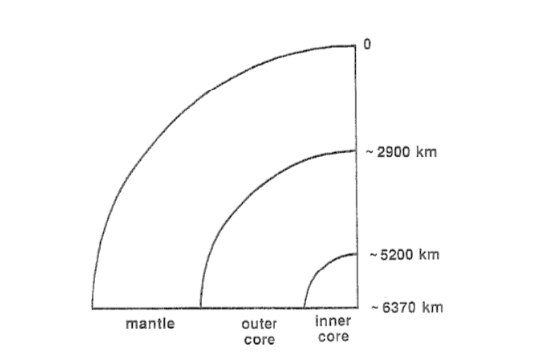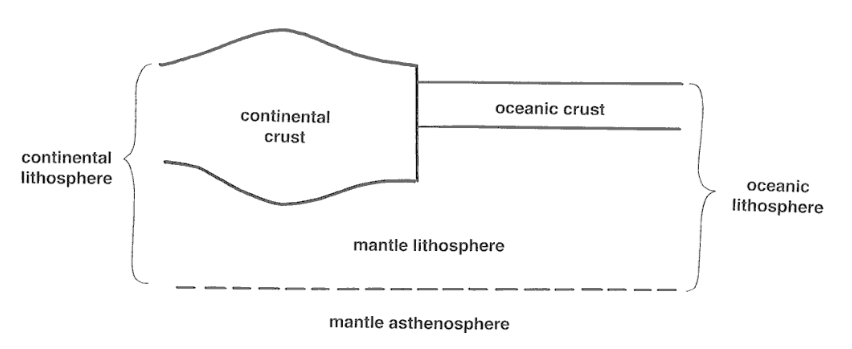2.1: The Earth - The Ground Beneath Your Feet
- Page ID
- 13462
To a great extent in this course, we will be dealing with processes that act on the solid materials at and near the Earth’s surface. This chapter might better be called “the ground beneath your feet”. This is the place to deal with the nature of the Earth’s surface materials, which in later sections of the chapter I will be calling regolith, sediment, and soil.
I purposely did not specify any previous knowledge of geology as a prerequisite for this course, so it is important, here in the first part of this chapter, for me to provide you with some background on Earth materials.
We will be dealing almost exclusively with the Earth’s continental surfaces. There are profound geological differences between the continents and the ocean basins, in terms of origin, age, history, and composition. Here I’ll present, very briefly, some basic things about geology. (For more depth on such matters you would need to take a course like “The Earth: What It Is, How It Works”, given in the Harvard Extension program in the fall semester of 2005– 2006 and likely to be offered again in the not-too-distant future.)
In a gross sense, the Earth is a layered body (Figure 2-1). To a first approximation, it consists of concentric shells: the core, the mantle, and the crust.

The core: The core consists mostly of iron, alloyed with a small percentage of certain other chemical elements. The outer part of the core is liquid, and the inner part is solid. There is no need here to deal with how that’s known—or indeed why there is an iron core in the first place.
The mantle: The mantle, which constitutes the greater part of the mass of the Earth, has its lower boundary, with the core, at a depth of about 2900 km.
(The radius of the Earth is about 6400 km.) The mantle consists almost entirely of solid rock, except for certain places in the uppermost mantle where magma (= melted rock) is formed at certain times. (There is a deplorably widespread and thoroughly mistaken belief that the upper mantle is everywhere molten.) Saying that the mantle is solid rock, true as that statement is, is somewhat misleading, though, because the solid rock of the mantle can flow plastically in the same way that a very viscous liquid, like honey or corn syrup, flows. You will see the same kind of behavior in glacier ice, in a later chapter. “Silly putty” is another good example of such a material. The uppermost part of the mantle, however, is sufficiently cool that it behaves not as a very stiff liquid but as a rigid solid. This situation, whereby the uppermost rigid part of the mantle (which, together with the overlying crust, is called the lithosphere) rides on the plastically flowing part of the mantle beneath (called the asthenosphere), is the basis for what is called plate tectonics (Figure 1-2).

The crust: The uppermost skin of the Earth, above the mantle, is called the crust (Figure 2-2). There are two basic kinds of crust, very different from one another in properties and origin: oceanic crust and continental crust. Oceanic crust is relatively thin, seldom more than seven to eight kilometers. Continental crust, on the other hand, is relatively thick, mostly thirty to fifty kilometers. The features of the upper surface of the continental crust, and the great variety of physical and chemical (and biological) processes and phenomena associated with that surface, are the focus of this course.
You probably know something about, or at least have heard about, plate tectonics. The lithosphere, the outermost part of the Earth, comprising the crust and the uppermost, rigid part of the mantle (Figure 2-2), is in the form of a number of segments, called lithospheric plates (or just plates), which are in contact with one another along what are called plate boundaries. The movements of these plates, and the consequences of those movements, especially in terms of what happens at plate boundaries, are collectively termed plate tectonics.
We could get along fairly well in this course without reference to the core or the mantle, or, for that matter, even to the lower part of the continental crust. Deep subsurface processes, in the crust and in the underlying upper mantle, have a great indirect importance to this course, however: such processes (the nature of which is beyond the scope of this course!) cause uplift and subsidence of the land surface of the continents, both sharp and localized, in the case of active mountain belts like the western Cordillera of North America, and broad and gentle, affecting large areas of the stable continent of North America east of the Cordillera. Uplift and subsidence, in turn, are instrumental in erosion, transportation, and deposition of sedimentary materials and in shaping of the surface topography of the continent. We’ll return to such matters in the final chapter.


